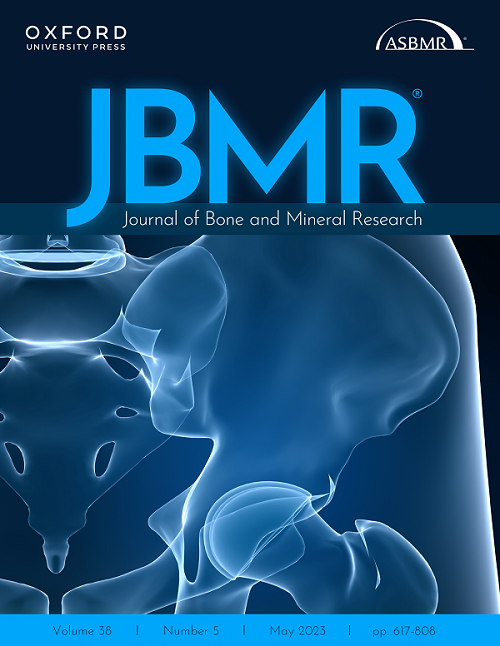下载PDF
{"title":"CT的机会筛查:无Phantomle BMD校准方法的比较。","authors":"Stefan Bartenschlager, Alexander Cavallaro, Tobias Pogarell, Oliver Chaudry, Michael Uder, Sundeep Khosla, Georg Schett, Klaus Engelke","doi":"10.1002/jbmr.4917","DOIUrl":null,"url":null,"abstract":"<p>Opportunistic screening is a new promising technique to identify individuals at high risk for osteoporotic fracture using computed tomography (CT) scans originally acquired for an clinical purpose unrelated to osteoporosis. In these CT scans, a calibration phantom traditionally required to convert measured CT values to bone mineral density (BMD) is missing. As an alternative, phantomless calibration has been developed. This study aimed to review the principles of four existing phantomless calibration methods and to compare their performance against the gold standard of simultaneous calibration (ΔBMD). All methods were applied to a dataset of 350 females scanned with a highly standardized CT protocol (DS1) and to a second dataset of 114 patients (38 female) from clinical routine covering a large range of CT acquisition and reconstruction parameters (DS2). Three of the phantomless calibration methods must be precalibrated with a reference dataset containing a calibration phantom. Sixty scans from DS1 and 57 from DS2 were randomly selected for this precalibration. For each phantomless calibration method first the best combination of internal reference materials (IMs) was selected. These were either air and blood or subcutaneous adipose tissue, blood, and cortical bone. In addition, for phantomless calibration a fifth method based on average calibration parameters derived from the reference dataset was applied. For DS1, ΔBMD results (mean <math>\n <mrow>\n <mo>±</mo>\n </mrow></math> standard deviation) for the phantomless calibration methods requiring a precalibration ranged from 0.1 <math>\n <mrow>\n <mo>±</mo>\n </mrow></math> 2.7 mg/cm<sup>3</sup> to 2.4 <math>\n <mrow>\n <mo>±</mo>\n </mrow></math> 3.5 mg/cm<sup>3</sup> with similar means but significantly higher standard deviations for DS2. Performance of the phantomless calibration method, which does not require a precalibration was worse (ΔBMD DS1: 12.6 <math>\n <mrow>\n <mo>±</mo>\n </mrow></math> 13.2 mg/cm<sup>3</sup>, DS2: 0.5 <math>\n <mrow>\n <mo>±</mo>\n </mrow></math> 8.8 mg/cm<sup>3</sup>). In conclusion, phantomless BMD calibration performs well if precalibrated with a reference dataset. © 2023 The Authors. <i>Journal of Bone and Mineral Research</i> published by Wiley Periodicals LLC on behalf of American Society for Bone and Mineral Research (ASBMR).</p>","PeriodicalId":185,"journal":{"name":"Journal of Bone and Mineral Research","volume":"38 11","pages":"1689-1699"},"PeriodicalIF":5.1000,"publicationDate":"2023-09-21","publicationTypes":"Journal Article","fieldsOfStudy":null,"isOpenAccess":false,"openAccessPdf":"https://asbmr.onlinelibrary.wiley.com/doi/epdf/10.1002/jbmr.4917","citationCount":"0","resultStr":"{\"title\":\"Opportunistic Screening With CT: Comparison of Phantomless BMD Calibration Methods\",\"authors\":\"Stefan Bartenschlager, Alexander Cavallaro, Tobias Pogarell, Oliver Chaudry, Michael Uder, Sundeep Khosla, Georg Schett, Klaus Engelke\",\"doi\":\"10.1002/jbmr.4917\",\"DOIUrl\":null,\"url\":null,\"abstract\":\"<p>Opportunistic screening is a new promising technique to identify individuals at high risk for osteoporotic fracture using computed tomography (CT) scans originally acquired for an clinical purpose unrelated to osteoporosis. In these CT scans, a calibration phantom traditionally required to convert measured CT values to bone mineral density (BMD) is missing. As an alternative, phantomless calibration has been developed. This study aimed to review the principles of four existing phantomless calibration methods and to compare their performance against the gold standard of simultaneous calibration (ΔBMD). All methods were applied to a dataset of 350 females scanned with a highly standardized CT protocol (DS1) and to a second dataset of 114 patients (38 female) from clinical routine covering a large range of CT acquisition and reconstruction parameters (DS2). Three of the phantomless calibration methods must be precalibrated with a reference dataset containing a calibration phantom. Sixty scans from DS1 and 57 from DS2 were randomly selected for this precalibration. For each phantomless calibration method first the best combination of internal reference materials (IMs) was selected. These were either air and blood or subcutaneous adipose tissue, blood, and cortical bone. In addition, for phantomless calibration a fifth method based on average calibration parameters derived from the reference dataset was applied. For DS1, ΔBMD results (mean <math>\\n <mrow>\\n <mo>±</mo>\\n </mrow></math> standard deviation) for the phantomless calibration methods requiring a precalibration ranged from 0.1 <math>\\n <mrow>\\n <mo>±</mo>\\n </mrow></math> 2.7 mg/cm<sup>3</sup> to 2.4 <math>\\n <mrow>\\n <mo>±</mo>\\n </mrow></math> 3.5 mg/cm<sup>3</sup> with similar means but significantly higher standard deviations for DS2. Performance of the phantomless calibration method, which does not require a precalibration was worse (ΔBMD DS1: 12.6 <math>\\n <mrow>\\n <mo>±</mo>\\n </mrow></math> 13.2 mg/cm<sup>3</sup>, DS2: 0.5 <math>\\n <mrow>\\n <mo>±</mo>\\n </mrow></math> 8.8 mg/cm<sup>3</sup>). In conclusion, phantomless BMD calibration performs well if precalibrated with a reference dataset. © 2023 The Authors. <i>Journal of Bone and Mineral Research</i> published by Wiley Periodicals LLC on behalf of American Society for Bone and Mineral Research (ASBMR).</p>\",\"PeriodicalId\":185,\"journal\":{\"name\":\"Journal of Bone and Mineral Research\",\"volume\":\"38 11\",\"pages\":\"1689-1699\"},\"PeriodicalIF\":5.1000,\"publicationDate\":\"2023-09-21\",\"publicationTypes\":\"Journal Article\",\"fieldsOfStudy\":null,\"isOpenAccess\":false,\"openAccessPdf\":\"https://asbmr.onlinelibrary.wiley.com/doi/epdf/10.1002/jbmr.4917\",\"citationCount\":\"0\",\"resultStr\":null,\"platform\":\"Semanticscholar\",\"paperid\":null,\"PeriodicalName\":\"Journal of Bone and Mineral Research\",\"FirstCategoryId\":\"3\",\"ListUrlMain\":\"https://onlinelibrary.wiley.com/doi/10.1002/jbmr.4917\",\"RegionNum\":1,\"RegionCategory\":\"医学\",\"ArticlePicture\":[],\"TitleCN\":null,\"AbstractTextCN\":null,\"PMCID\":null,\"EPubDate\":\"\",\"PubModel\":\"\",\"JCR\":\"Q1\",\"JCRName\":\"ENDOCRINOLOGY & METABOLISM\",\"Score\":null,\"Total\":0}","platform":"Semanticscholar","paperid":null,"PeriodicalName":"Journal of Bone and Mineral Research","FirstCategoryId":"3","ListUrlMain":"https://onlinelibrary.wiley.com/doi/10.1002/jbmr.4917","RegionNum":1,"RegionCategory":"医学","ArticlePicture":[],"TitleCN":null,"AbstractTextCN":null,"PMCID":null,"EPubDate":"","PubModel":"","JCR":"Q1","JCRName":"ENDOCRINOLOGY & METABOLISM","Score":null,"Total":0}
引用次数: 0
引用
批量引用



